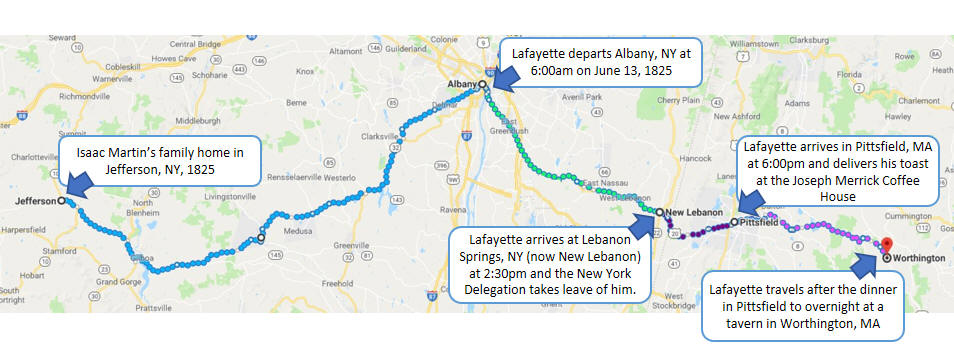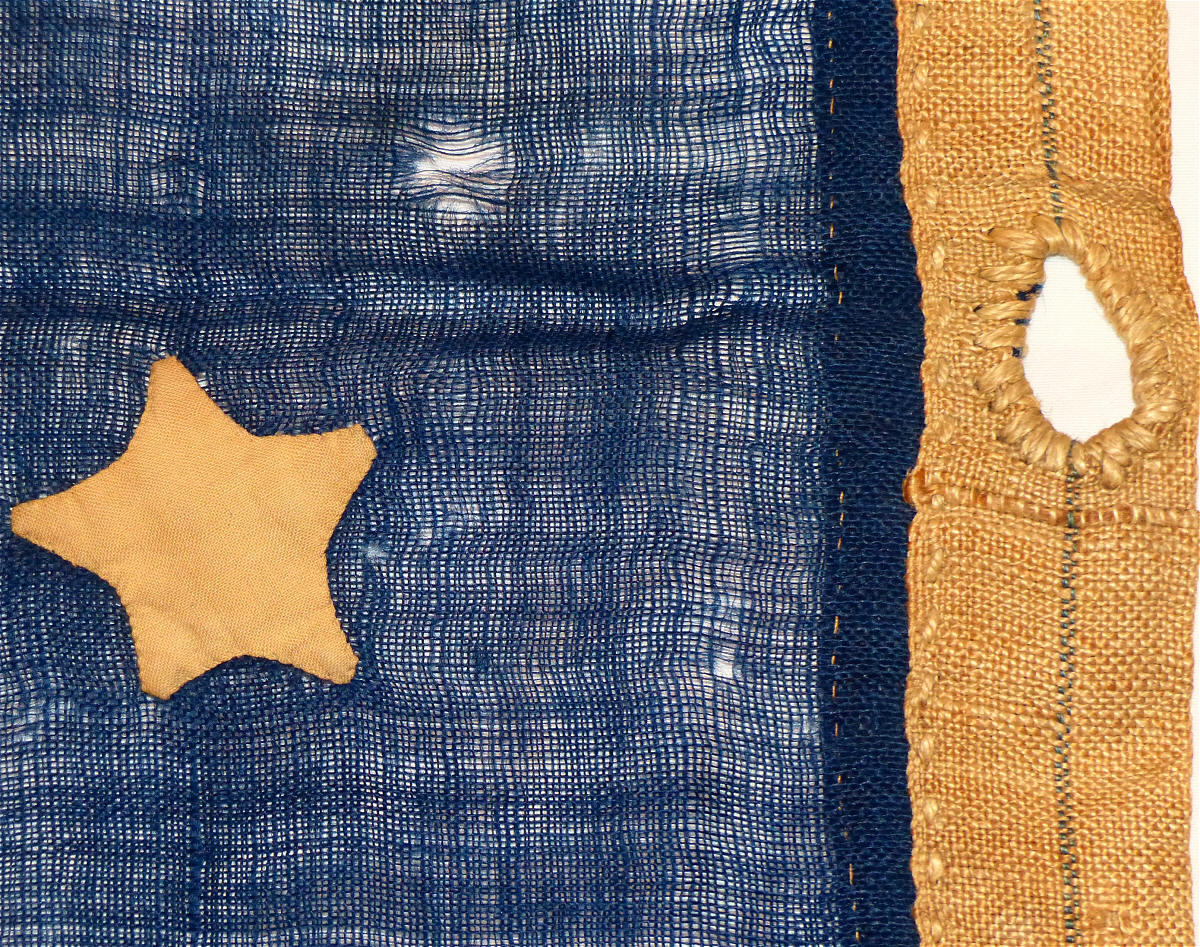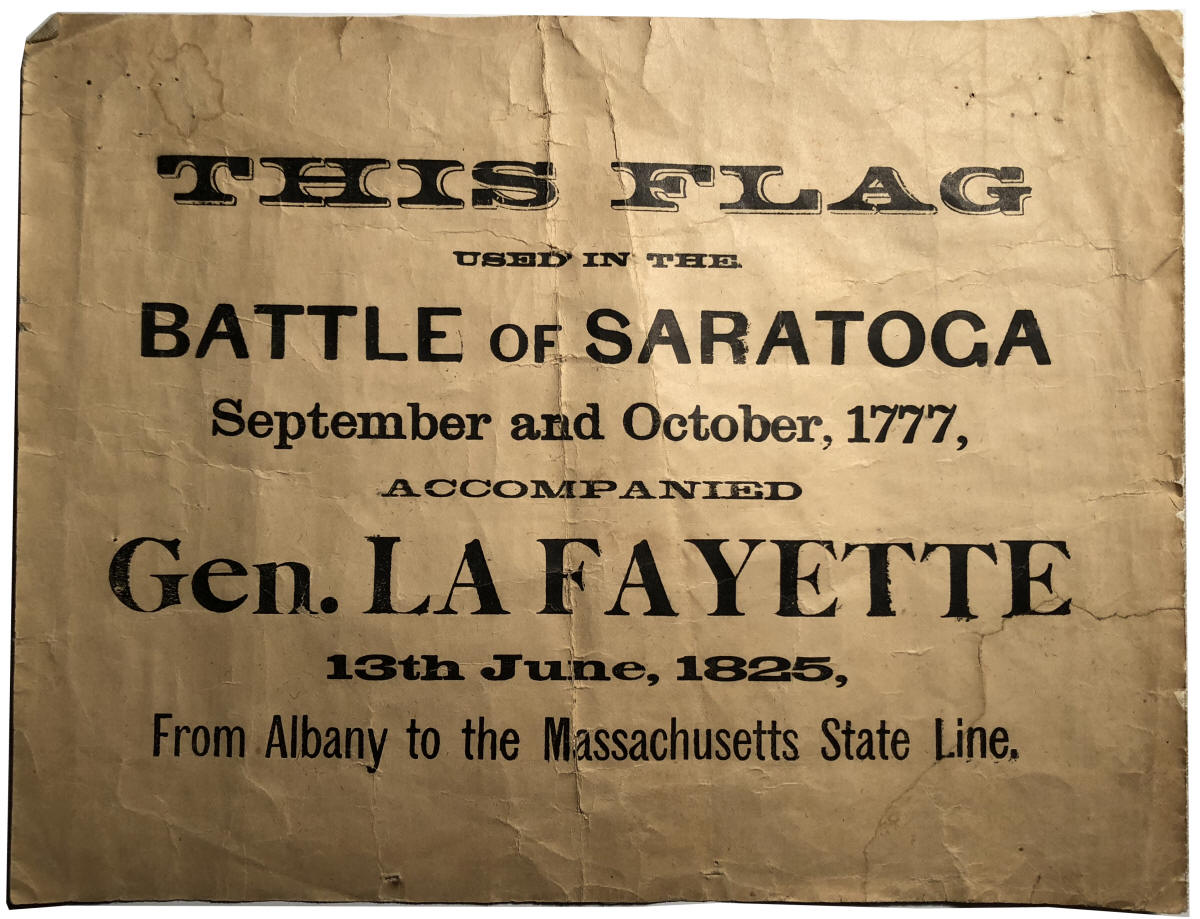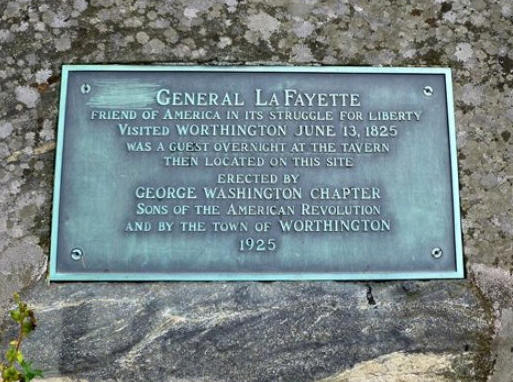|
The Lafayette Flag is
one of the most unique and interesting early flags in
the Rare Flags collection, in part because of its age,
which dates to the earliest era of American flag making,
pre-1830, as well as its extraordinary historical
connection with the Marquis de Lafayette, a luminary of
the American Revolution. Several aspects of this flag's
construction and family history contribute to the
veracity of the flag's history that it was carried in Lafayette's
procession from Albany, New York to the Massachusetts
state line on June 13, 1825.
The provenance of the
flag is that it descended in the Martin family, who
trace their lineage back to William Martin (born 1590 in
Dorset, England) and Elizabeth Martin (nee Maunsell)
(born 1584, Sussex, England), who were among the first
settlers of Connecticut; through their son Lieutenant
Samuel Martin, Sr. (born 1613 in New Haven, Connecticut)
and his wife Phoebe Martin (nee Bracey) (born 1611 in
London, England); through their son William Seaborn Martin, born circa 1653,
(born at sea while his parents were returning to New
Haven, Connecticut from England, hence a fitting middle
name!) and his wife Abigail Martin (nee Nichols) (born
1663 in Stratford, Connecticut).
In
examining the line of descent from the previous owner of
the flag from which it was acquired, the likely owner of
the flag can be
narrowed to three individuals: Isaac Martin, (b. 5 Apr
1757, d. 6 Nov 1832), his son Philo Martin (b. 29 Jul
1783, d. 22 Apr 1847), or his grandson Homer Martin (b.
12 Sep 1804, d. 7 Apr 1886), all of whom are direct
ancestors of the previous owner. They would have been 67
years old, 42 years old, and 21 years old, respectively,
at the time of Lafayette's visit to Albany in 1825. Also
important is the fact that Isaac Martin was veteran of
the American Revolution.
| Isaac
Martin, born in 1757, died Nov. 6, 1832, at
the age of seventy-five, and was buried in
the Middle Ridge Cemetery in Madison, Lake
County, Ohio. He enlisted early in the
Revolutionary War in the Connecticut
Troops. He served in the first regiment of
Gen. Wooster, in the ninth company under
Capt. James Arnold, and 1st lieutenant James
Blakesley on the first call for troops. The
regiment marched for the protection of New
York, and later engaged in the affairs of
Lake George and Lake Champlain. He was
discharged on November 25, 1775, and
received a pension.1
|
During
Lafayette's visit, surviving Revolutionary War
veterans came from surrounding areas to see
Lafayette and they were celebrated for their service
to the cause. Accounts from Lafayette's visit for
June 13, 1825, specifically mention Revolutionary
War veterans attending the festivities in
Pittsfield, Massachusetts and at his final arrival
that evening in Worthington, Massachusetts.
It is
important to determine the proximity of Isaac, Philo
and Homer to the events of June 13, 1825 in Albany.
Isaac married Mary Baldwin (b. 6 Nov 1760, d. 8 Mar,
1833) and together they had five children, all born
in Woodbury, Litchfield County, Connecticut (the
latest birth being Anna Martin, b. 1796). Philo
Martin was their oldest child, and he married Fanny
Hurd (b. 6 Dec 1780, d. 19 Aug 1841). Philo and
Fanny had ten children. Birth records for Philo and
Fanny's children show that their last two children,
Joel Martin (b. 1821), and Isaac Mitchell Martin (b.
1824), were born in the town of Jefferson,
Schoharie, New York, which is just 50 miles from
Albany. This places Philo and his family in the area
of Albany at the time of Lafayette's visit
(1824-1825). In fact, Homer Martin, Philo and
Fanny's oldest son, married Sarah Dodge of Albany on
June 27, 1827, just two years after Lafayette's
visit. What ties Isaac Martin to this location is
the fact that all four of them--Isaac, Mary, Philo
and Fanny--are buried together at the Middle Ridge
Cemetery in Madison, Lake County, Ohio. It's
clear that the entire family made their way from
their roots in Connecticut, to the Albany, New York
area in the 1820's, and eventually settled in their
last years in Madison, Ohio. Given the line of
descent of the flag, through Homer Martin, it's
evident that the flag remained with Homer in Albany
after Isaac, Mary, Philo and Fanny departed for
Ohio. Homer and Sarah remained in Albany and Homer
died and was buried there in 1886.
Just
how close the Martin family lived to the events of
Lafayette's travels on June 13, 1825, is apparent in
the map below. In just one day, on June 13,
Lafayette traveled over 60 miles from Albany, NY
through Lebanon Springs, NY to Pittsfield, MA and on
to Worthington, MA where he spent the night.
As you can see from the map below, the Martin family
lived in Jefferson, NY, just one day's travel from
Albany, NY, approximately the same distance that
Lafayette traveled. It's likely the Martin family
made the trip to Albany some days before June 13th
with their flag and traveled along with Lafayette
and the New York delegation from Albany to Lebanon
Springs before returning home.

 In
addition to the
Martin family history,
the flag itself is
correct for the 1820's period.
Unlike later Civil War
era flags, the flag is constructed of a coarser
early machine-loomed British wool. Its construction
and materials closely match several other 1810-1830 era flags in the
Rare Flags collection, including an original 15 Star
Flag (IAS-00377),
an original 20 Star Flag (IAS-00255),
and two original 24 Star Flags (IAS-00398
and
IAS-00319) . The flag has early traits,
such as the fold-over of the edge of the wool where
the canton and stripes meet the hoist. The hoist is
made of a hemp canvas rather than cotton, also a
trait of very early flags. It is sewn to the flag
using thicker yarn-like thread and has whip-stitched
grommets. The flag is entirely hand-sewn and nothing
precludes it from dating to 1825 or earlier. In
addition to the
Martin family history,
the flag itself is
correct for the 1820's period.
Unlike later Civil War
era flags, the flag is constructed of a coarser
early machine-loomed British wool. Its construction
and materials closely match several other 1810-1830 era flags in the
Rare Flags collection, including an original 15 Star
Flag (IAS-00377),
an original 20 Star Flag (IAS-00255),
and two original 24 Star Flags (IAS-00398
and
IAS-00319) . The flag has early traits,
such as the fold-over of the edge of the wool where
the canton and stripes meet the hoist. The hoist is
made of a hemp canvas rather than cotton, also a
trait of very early flags. It is sewn to the flag
using thicker yarn-like thread and has whip-stitched
grommets. The flag is entirely hand-sewn and nothing
precludes it from dating to 1825 or earlier.
A sign
printed on oil cloth from the later 19th century
descended with the flag and seems to have been
pinned to the flag's fly end at one point in time.
While the precise date of the sign is difficult to
determine,
 the style of the printing, which involves
different font types and casing for each line of the
text is indicative of the style used on printed
ephemera from the
1870-1890
period. Many examples of this type of printing
are found on the 19th century
printed advertising flag cards that date to the
1880 election. It's most likely that the sign dates
to the American Centennial in 1876, at the height of
patriotic celebration, when relics of the early
American republic, especially those with ties to
Revolutionary War heroes, were brought out across
the country for display and admiration. Although the
entire flag was originally hand-sewn, there areas
where a treadle sewing machine was used to repair
the flag, to include applying some patches to the
canton and lower stripe. The repairs date to this
era, likely done when the flag was prepared for
display. the style of the printing, which involves
different font types and casing for each line of the
text is indicative of the style used on printed
ephemera from the
1870-1890
period. Many examples of this type of printing
are found on the 19th century
printed advertising flag cards that date to the
1880 election. It's most likely that the sign dates
to the American Centennial in 1876, at the height of
patriotic celebration, when relics of the early
American republic, especially those with ties to
Revolutionary War heroes, were brought out across
the country for display and admiration. Although the
entire flag was originally hand-sewn, there areas
where a treadle sewing machine was used to repair
the flag, to include applying some patches to the
canton and lower stripe. The repairs date to this
era, likely done when the flag was prepared for
display.
Another interesting trait of this flag is the
shortness of the stripes. The flag was originally
much longer, but the fly end of the flag was
intentionally cut, and was not re-hemmed, as would
be expected if the
 end was repaired due to wind
damage. Instead, it is evidence that the flag was "souvenired",
whereby pieces were cut and taken to commemorate a
significant event. end was repaired due to wind
damage. Instead, it is evidence that the flag was "souvenired",
whereby pieces were cut and taken to commemorate a
significant event.
There
is no documented evidence of the use of the
"Stars-and-Stripes" at the Battle of Saratoga, and
it is historically very unlikely, a flag of that
style would have been present. The First Flag Act
was only passed in June, 1777, a few months before
the battle, and word had not yet reached remote
places about the new flag's design. Nor did the flag
act direct that the national flag be used for
military purposes. In fact, it is uncertain whether
George Washington ever flew a "Stars-and-Stripes"
during any of his campaigns. It's possible that
Homer Martin, just 21 years old at the time of
Lafayette's visit, was told family lore, perhaps by
his grandfather Isaac, that the flag was from the
battle, though Isaac was already discharged from the
Army at the time of Saratoga. In any case, in 1876
when the sign was likely made, Homer Martin would
personally have remembered participating in the
procession with Lafayette in 1825. Homer's son,
Edmund Philo Martin, was born in 1829 and eventually
moved to New York City by the 1890's. The flag
passed from Homer to Edmund, and on to Edmond's son,
Reginald Pearl Martin, who moved from New York City
to York, Maine, where the flag remained with
descendants of Reginald until its acquisition in
2018.
In
conclusion, all evidence in the research of this
flag indicates that it descended in a family
directly associated with Albany, NY in the 1825
period when Lafayette visited and made his trip on
June 13, 1825, from Albany to the Massachusetts
state line. The family lineage includes a
Revolutionary War veteran, hero and patriot, who
would have been an honored guest at such a
celebration as General Lafayette's visit. The flag
itself is correct in materials and construction for
the period.
1
The History of Ancient
Woodbury, William Cothren, 1854
Provenance:
Isaac Martin, 1757-1832
to Philo Martin, 1783-1847
to Homer Martin, 1804-1886
to Edmund Philo Martin, 1829-Unknown
to Reginald Pearl Martin, 1875-1958
to Howard Burt Martin, 1912-1991
to Judith Martin, acquired from Judith Martin for the
Rare Flags Collection, March, 2018. |

